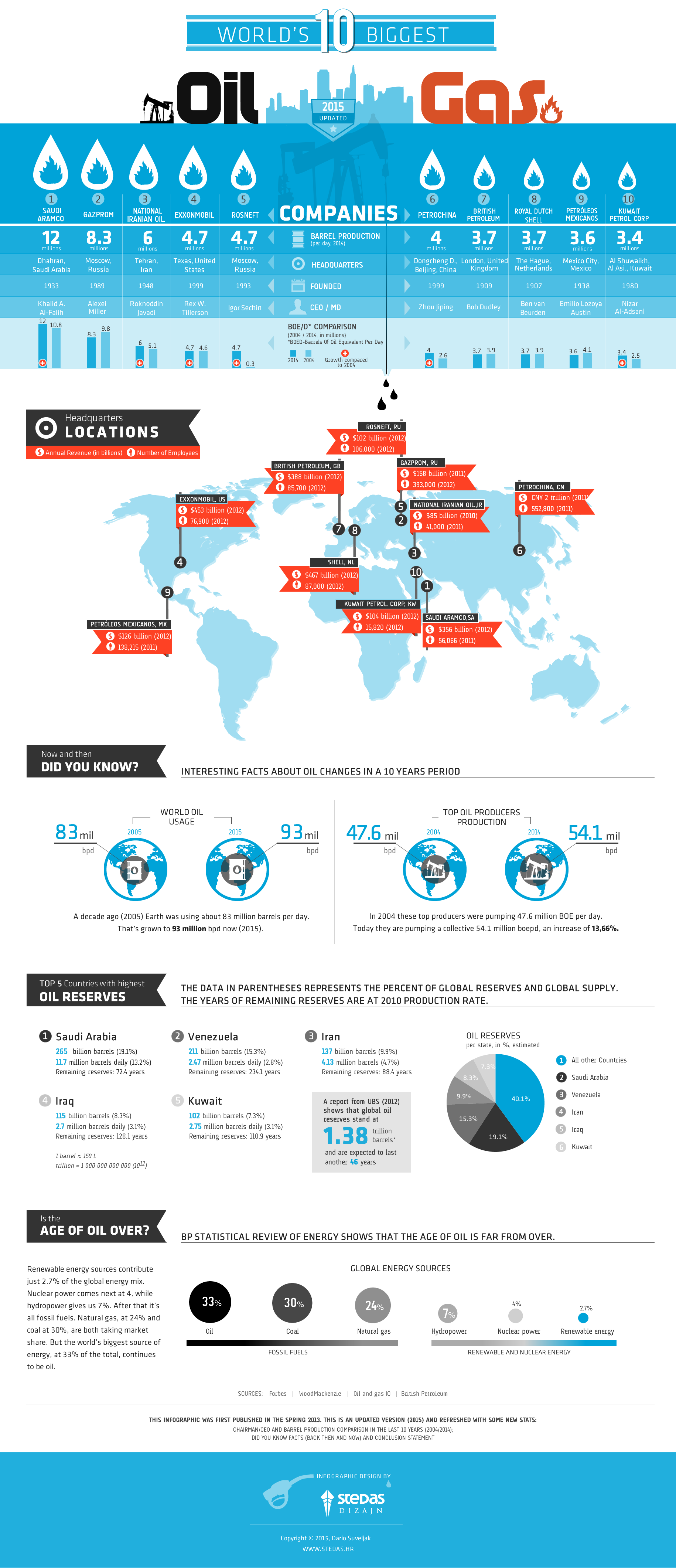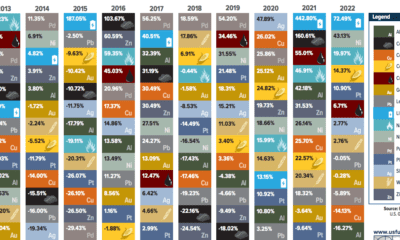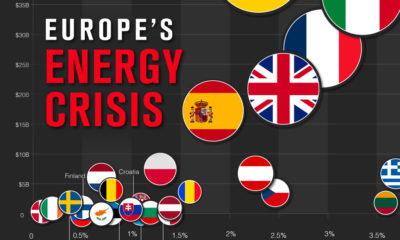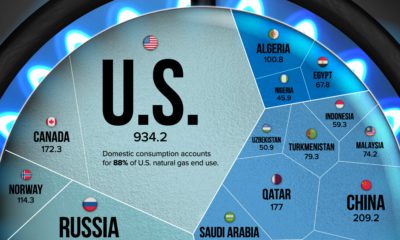The World’s 10 Biggest Oil and Gas Companies
Note: to see the bigger version of this infographic, click here. Today’s infographic not only ranks oil producers based on factors such as barrel production per day, but it also compares data from a decade ago with today’s information for better perspective. From 2005 to 2015, global oil usage has only increased from 83 million to 93 million bpd (1.13% CAGR). However, the overall rate at which the Top 10 has grown production has been at a 1.29% CAGR pace, and their production now makes up about 58% of all global production. The companies with the most impressive increases over this time are all state-owned. Saudi Aramco, the world’s largest producer, increased production from 10.8 million bpd (2004) to 12 million bpd (2014). Rosneft, National Iranian Oil, Petrochina, and Kuwait Petrol Corp all saw sizeable increases. The only company to see a big decrease was also state-owned (Gazprom). Oil and gas continues to make up the majority of the global energy mix with 33% and natural gas at 24%. That said, based on the CAGRs above, it does seem that we are making progress in tapering the growth of production. Human population and the economy are growing at rates higher than 1.13%, so that means oil is giving up ground to other energy sources. If you liked visuals on the world’s 10 biggest oil and gas companies, don’t forget to view our presentation on how much oil and other energy types it takes to power New York for a year, or our chart on which country has parabolic growth in wind power capacity. Original graphic by: Stedas
on
#1: High Reliability
Nuclear power plants run 24/7 and are the most reliable source of sustainable energy. Nuclear electricity generation remains steady around the clock throughout the day, week, and year. Meanwhile, daily solar generation peaks in the afternoon when electricity demand is usually lower, and wind generation depends on wind speeds.As the use of variable solar and wind power increases globally, nuclear offers a stable and reliable backbone for a clean electricity grid.
#2: Clean Electricity
Nuclear reactors use fission to generate electricity without any greenhouse gas (GHG) emissions.Consequently, nuclear power is the cleanest energy source on a lifecycle basis, measured in CO2-equivalent emissions per gigawatt-hour (GWh) of electricity produced by a power plant over its lifetime. The lifecycle emissions from a typical nuclear power plant are 273 times lower than coal and 163 times lower than natural gas. Furthermore, nuclear is relatively less resource-intensive, allowing for lower supply chain emissions than wind and solar plants.
#3: Stable Affordability
Although nuclear plants can be expensive to build, they are cost-competitive in the long run. Most nuclear plants have an initial lifetime of around 40 years, after which they can continue operating with approved lifetime extensions. Nuclear plants with lifetime extensions are the cheapest sources of electricity in the United States, and 88 of the country’s 92 reactors have received approvals for 20-year extensions. Additionally, according to the World Nuclear Association, nuclear plants are relatively less susceptible to fuel price volatility than natural gas plants, allowing for stable costs of electricity generation.
#4: Energy Efficiency
Nuclear’s high energy return on investment (EROI) exemplifies its exceptional efficiency. EROI measures how many units of energy are returned for every unit invested in building and running a power plant, over its lifetime. According to a 2018 study by Weissbach et al., nuclear’s EROI is 75 units, making it the most efficient energy source by some distance, with hydropower ranking second at 35 units.
#5: Sustainable Innovation
New, advanced reactor designs are bypassing many of the difficulties faced by traditional nuclear plants, making nuclear power more accessible.
Small Modular Reactors (SMRs) are much smaller than conventional reactors and are modular—meaning that their components can be transported and assembled in different locations. Microreactors are smaller than SMRs and are designed to provide electricity in remote and small market areas. They can also serve as backup power sources during emergencies.
These reactor designs offer several advantages, including lower initial capital costs, portability, and increased scalability.
A Nuclear-Powered Future
Nuclear power is making a remarkable comeback as countries work to achieve climate goals and ultimately, a state of energy utopia. Besides the 423 reactors in operation worldwide, another 56 reactors are under construction, and at least 69 more are planned for construction. Some nations, like Japan, have also reversed their attitudes toward nuclear power, embracing it as a clean and reliable energy source for the future. CanAlaska is a leading exploration company in the Athabasca Basin, the Earth’s richest uranium depository. Click here to learn more now. In part 3 of the Road to Energy Utopia series, we explore the unique properties of uranium, the fuel that powers nuclear reactors.






























